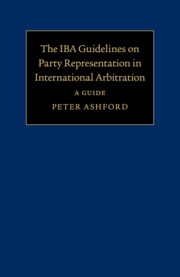Book contents
- Frontmatter
- Contents
- Dedication
- Preface and dedication
- Cases
- About the IBA Arbitration Committee
- The Guidelines
- Definitions
- Guidelines 1–3
- Guidelines 4–6
- Guidelines 7–8
- Guidelines 9–11
- Guidelines 12–17
- Guidelines 18–25
- Guidelines 26–27
- Appendix 1 Extract from the LCIA Arbitration Rules 2014 and Annex to the LCIA Rules
- Appendix 2 Interaction of IBA Rules with major professional conduct rules
- Appendix 3 Interaction of IBA Rules with major institutional rules
- Index
The Guidelines
Published online by Cambridge University Press: 05 July 2016
- Frontmatter
- Contents
- Dedication
- Preface and dedication
- Cases
- About the IBA Arbitration Committee
- The Guidelines
- Definitions
- Guidelines 1–3
- Guidelines 4–6
- Guidelines 7–8
- Guidelines 9–11
- Guidelines 12–17
- Guidelines 18–25
- Guidelines 26–27
- Appendix 1 Extract from the LCIA Arbitration Rules 2014 and Annex to the LCIA Rules
- Appendix 2 Interaction of IBA Rules with major professional conduct rules
- Appendix 3 Interaction of IBA Rules with major institutional rules
- Index
Summary
PREAMBLE
The IBA Arbitration Committee established the Task Force on Counsel Conduct in International Arbitration (the ‘Task Force’) in 2008.
The mandate of the Task Force was to focus on issues of counsel conduct and party representation in international arbitration that are subject to, or informed by, diverse and potentially conflicting rules and norms. As an initial enquiry, the Task Force undertook to determine whether such differing norms and practices may undermine the fundamental fairness and integrity of international arbitral proceedings, and whether international guidelines on party representation in international arbitration may assist parties, counsel and arbitrators. In 2010, the Task Force commissioned a survey (the ‘Survey’) in order to examine these issues. Respondents to the Survey expressed support for the development of international guidelines for party representation.
The Task Force proposed draft guidelines to the IBA Arbitration Committee's officers in October 2012.
The Committee then reviewed the draft guidelines and consulted with experienced arbitration practitioners, arbitrators and arbitral institutions. The draft guidelines were then submitted to all members of the IBA Arbitration Committee for consideration. Unlike in domestic judicial settings, in which counsel are familiar with, and subject, to, a single set of professional conduct rules, party representatives in international arbitration may be subject to diverse and potentially conflicting bodies of domestic rules and norms. The range of rules and norms applicable to the representation of parties in international arbitration may include those of the party representative's home jurisdiction, the arbitral seat, and the place where hearings physically take place. The Survey revealed a high degree of uncertainty among respondents regarding what rules govern party representation in international arbitration. The potential for confusion may be aggravated when individual counsel working collectively, either within a firm or through a co-counsel relationship, are themselves admitted to practise in multiple jurisdictions that have conflicting rules and norms.
In addition to the potential for uncertainty, rules and norms developed for domestic judicial litigation may be ill-adapted to international arbitral proceedings.
Indeed, specialised practices and procedures have been developed in international arbitration to accommodate the legal and cultural differences among participants and the complex, multinational nature of the disputes. Domestic professional conduct rules and norms, by contrast, are developed to apply in specific legal cultures consistent with established national procedures.
- Type
- Chapter
- Information
- The IBA Guidelines on Party Representation in International ArbitrationA Guide, pp. 2 - 17Publisher: Cambridge University PressPrint publication year: 2016

